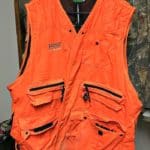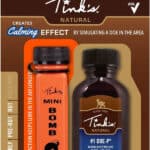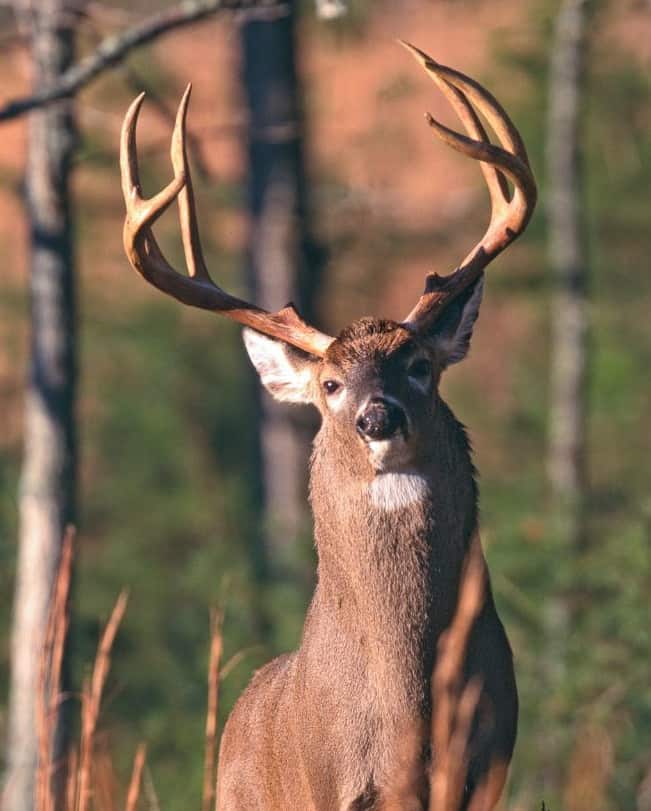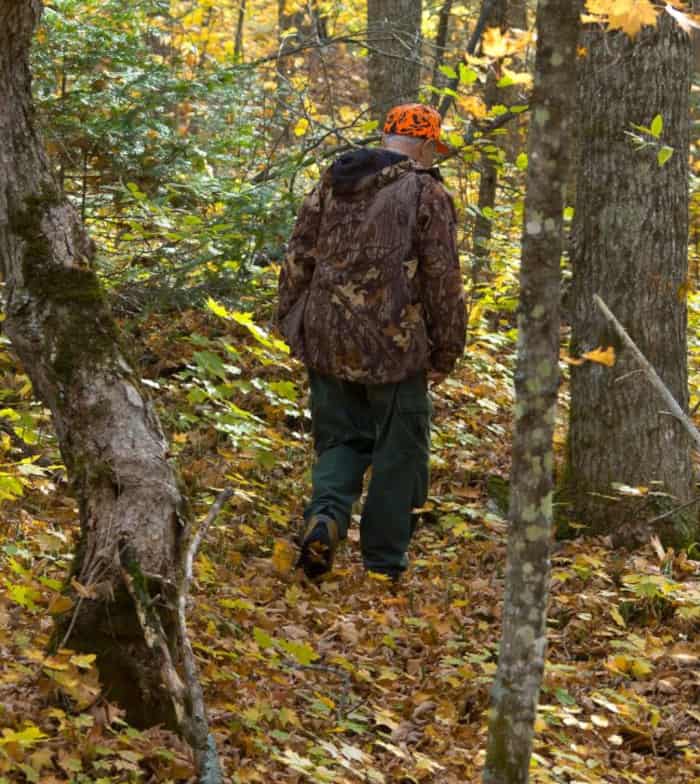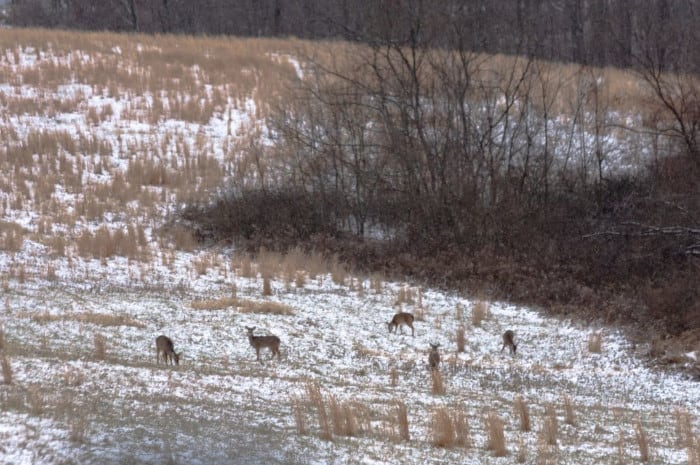At my day job, I have the opportunity to pretty much talk about hunting all day, and a great deal of that time is spent answering or trying to answer various hunting-related questions. One question that I hear asked over and over is, why am I not seeing deer while hunting? While it can be challenging to answer that question without having all the pertinent details, here are seven primary reasons that you do not see deer while hunting.
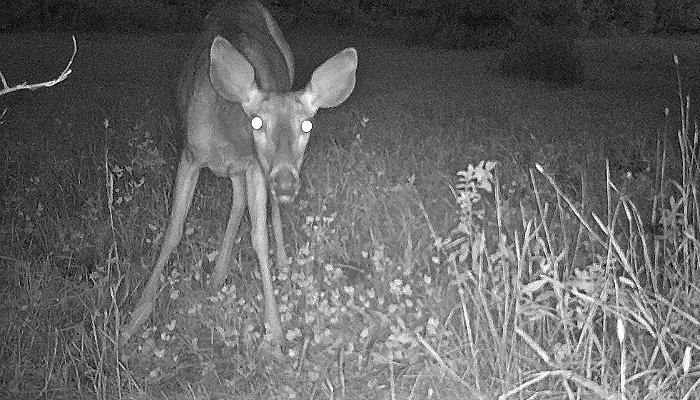
#1 – Hi-Impact Preseason Scouting
Preseason scouting is almost a requirement for successfully hunting whitetails. However, preseason scouting is also a double-edged sword. While it’s an integral part of the hunting process, it can also work against the hunter when the deer are disturbed.
Whitetail deer are relatively intelligent animals that leverage their natural instincts to avoid danger and threats. So, when a mature whitetail starts seeing more humans in the woods than usual, odds are he will follow his instincts and move to another area with fewer people.
So how does a hunter scout an area and not disturb the deer? The answer is a low-impact scouting plan.
A low-impact scouting approach means that the hunter is taking steps to reduce their proverbial footprint in the woods in an effort to spook fewer deer. For me, low-impact scouting involves leveraging technology to reduce the amount of needed in-person scouting.
Here are a few examples of how I leveraged technology to reduce my preseason scouting:
Cellular-based Game Cameras
With a cellular-based game camera, I have the images automatically sent to my phone. This significantly reduces the number of times I must enter my hunting area to check cameras. If you’re on the frugal side (like me) and don’t want to spend the money on cellular game cameras or the monthly cellular fees, max out the SD card or data media in your trail cameras, so they have more storage space. This approach allows for more images on the media, so you don’t have to come in to check the camera cards as much.
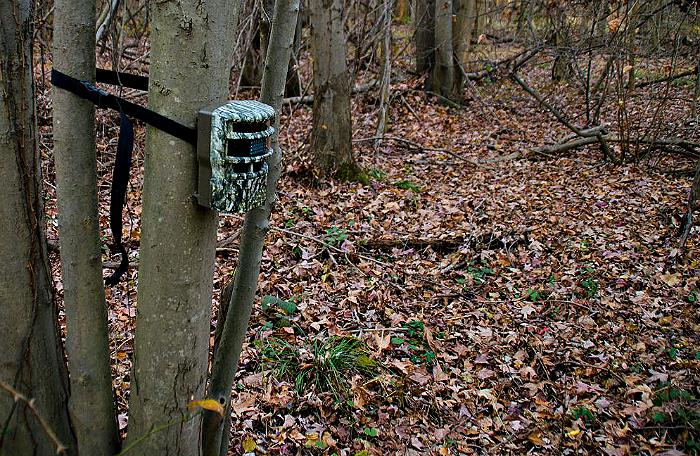
Higher-capacity Deer Feeders
Here’s another way I try putting technology on my side for hunting: when it comes time to replace a deer feeder, I’ve been upgrading feeder models with a larger hopper that holds more feed. For example, I’ve been migrating from feeder models holding 30 gallons of feed to 60 gallons (where applicable). These larger capacity feeders hold more feed, so I don’t have to refill them as much.
If you prefer to stick with the feeder capacity that you are already using, one alternative suggestion is to reduce either the volume of feed being distributed by each feeder or reduce the number of times that the feeder activates each day. These approaches will make the feed in the feeder last longer, so you are in the woods less for refills.
Switch To Solar-Powered Deer Feeders
Most all the popular deer feeder brands now offer a solar charging option that uses solar power to charge the batteries in the feeder. This solar-powered approach equates to a longer battery life compared to traditional alkaline batteries, so a hunter is not required to change the feeder battery or batteries as often.
If your deer feeder is an older model, there’s a good chance that you can find a kit that will convert it over to solar power.
Employing A Drone
I haven’t tried this approach, but I know some deer hunters who like to use a small drone for aerial surveys of the land. The most effective style of drone seems to be the smaller, more quiet models equipped with a video camera.
Drones can be beneficial in locating deer trails, travel paths, bedding areas, and food sources, all without ever entering the woods. In addition, using a drone allows hunters to get a birds-eye view of the land with minimal disturbance.
Obviously, drones also come with some downsides, including the cost, range, camera quality, learning curve, etc., so they probably aren’t for everyone.
#2 – Spooking Deer When Coming To Or From A Stand
Even though I consider myself an above-average deer hunter with a pretty diverse set of hunting experiences, I still make mistakes. One of those mistakes is bumping or spooking deer when heading to or from a stand.
When a hunter spooks a deer, that whitetail deer running through the woods will most likely spook other whitetails. Deer are herd animals, so when one animal flees, other animals in that species will flee as well, even if they haven’t detected any danger themselves.
If you’re spooking deer when heading to or from a stand, here are a few suggestions that might help:
Change Your Entrance And Exit Routes
If you’re bumping deer every time you head to your deer stand, it might be time to change your entrance route. I try to find a way to my stand that offers the quietest approach and keeps me downwind of my stand. I understand that wind direction changes all the time, and the downwind suggestion is difficult to maintain, but the idea here is to slip into and out of your stand as quietly as possible.
Get To The Stand Earlier Or Later
Another way to reduce the chances of spooking deer involves getting into the stand well before the first light. If I bump deer while coming to a stand in the early morning, and can’t change my entrance route, then I’ll come to the stand one hour earlier than before. While deer are semi-nocturnal, they are not out foraging all night. Coming to the stand earlier than before gives you a chance to slip into the woods while they are still bedded down.
Stay In The Stand All Day
Another option that might help would be staying in the stand all day instead of leaving for lunch and returning for an afternoon hunt. I’ll be honest and say that this approach is challenging for me as it makes for a long time to be on a deer stand. However, it can pay big dividends if a trophy buck walks by.
In those cases, I’ll pack a lunch and some snacks in my hunting pack and make it all day hunt. From a lunch perspective, I’d suggest making something without a lot of aroma (stay away from a tuna sandwich). I also recommend bringing some kind of set-up for bathroom breaks as well.
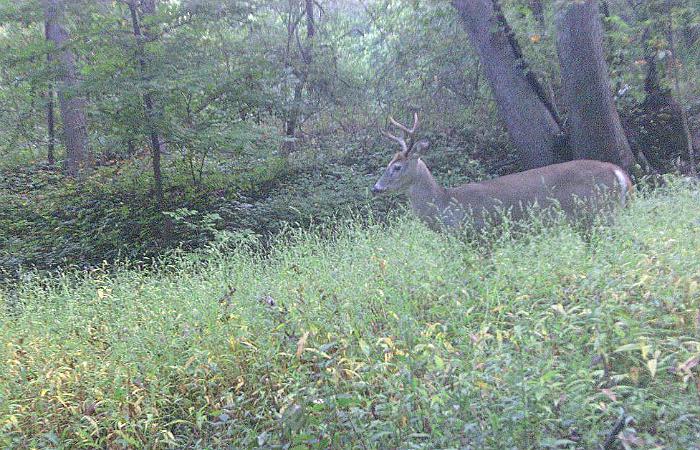
#3 – Scent Control Issues
A whitetail’s best self-defense mechanism is its extremely sensitive sense of smell. Unfortunately, this fantastic sense of smell is another potential concern that could be causing you not to see any deer while hunting. Trying to minimize your human odors goes by several different names, but I prefer to call it scent control.
Notice that I used the term scent control versus scent elimination? I bring this up as it’s impossible to eliminate your human odors completely. For example, as we breathe, we expel scents that a nearby deer can potentially pick up.
Now, at this point in the post, I probably know what you’re thinking. You’re saying to yourself: But my great grandfather’s third cousin’s brother killed a HUGE whitetail deer in 1944 before scent control was even a thing, so why do I need it now?
You don’t necessarily “need” to practice scent control or scent reduction for hunting, as I know hunters who have harvested outstanding bucks without using any odor elimination products or practices.
However, those are more likely examples of either good luck or having the good fortune to be hunting upwind of the deer.
In truth, more deer are probably never seen due to picking up a strange scent compared to all the other everyday situations that spook deer. And, if your smell is picked up far away, you may not even know that deer were in the area at all.
Over the course of my hunting experiences, I’ve had several instances where the wind shifted, or my scent control measures were not good enough, and my odor or some other strange smell ran deer away from my location.
As I mentioned before, it’s impossible to eliminate your smell entirely, and practicing sound scent reduction is not a guaranteed recipe for success. However, it can only help reduce your overall human footprint in the woods.
If you want to test out some additional odor removal or reduction practices for deer, here are a few suggestions:
Only Wear Your Hunting Boots In The Woods
One part of scent reduction that hunters seem to forget is their boots. While you can spray or treat boots with a scent-killing spray, the outside boot foot sole can pick up all kinds of foreign odors if you wear the boots anywhere outside the woods.
I prefer to keep the boots in a paper bag and put them on when I arrive at the land to hunt. Then I take them off and put them back into the paper bag when I finish hunting.
While some might call this approach a little extreme, the only scent on the sole of my boots is natural scents that are found in the same area as the whitetails I hunt.
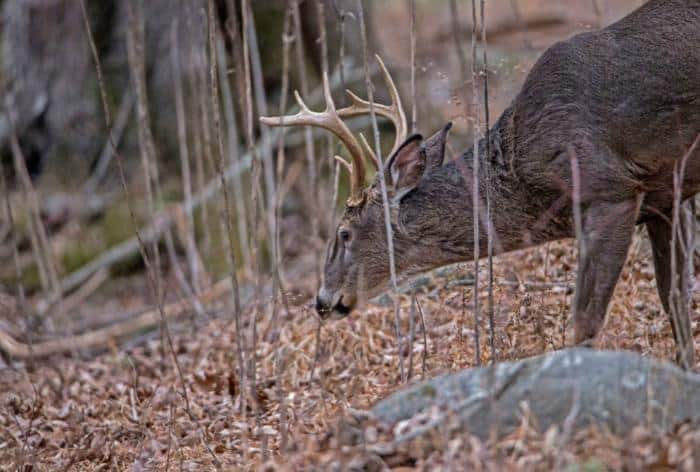
De-scent Your Hunting Pack
It’s not uncommon for deer hunters to de-scent their hunting clothes and hunt gear but forget to remove or cover up any human scent on their deer hunting pack.
I suggest treating the hunting pack as a part of your clothing and minimizing your scent on it.
Use A Sealed Plastic Bag To Store Any Items That Have Their Own Odor
I typically use one-gallon plastic sandwich-style bags with a sealing feature to separately store items such as:
- Food
- Scent elimination products
- Scent attraction products
- First aid kit
- Calls
All those items potentially have their own smell, so keeping them stored in a sealed plastic bag inside a hunting pack helps eliminate or reduce the odor from those items.
#4 – Hunting Old Or Inactive Deer Sign
A key piece for successful deer hunting involves locating and interpreting signs that indicate the presence of deer. However, like most things in life, finding and reading those deer signs are learned over time and with experience. I was fortunate to have an uncle who was an experienced woodman who started my education on deer signs and how to interpret them.
New and inexperienced deer hunters may have no trouble locating signs of deer but may struggle to identify the age of the sign, which can be an issue. Hunting over an old scrape that hasn’t been visited in weeks probably won’t be a very effective use of time.
With deer sign, it’s essential to focus on fresh and active evidence as that paints a picture of the deer activity within the last few days versus the last few weeks.
Here are a few suggestions that might help newer hunters evaluate the freshness of deer signs:
Deer Scrapes
One of the easiest types of deer evidence to evaluate is scrapes. A deer scrape is a location where a buck has scratched up the ground and marked it with its urine. He may also rub his face over a nearby low-hanging branch to mark it as well.
An active scrape is one where a buck or bucks keeps the scrape area cleared of leaves and debris. An older scrape site will have debris accumulating in the scrape area.
However, the easiest way to gauge the activity at a scrape is to put a trail camera on it. The trail camera data will help identify if, when, and how often the scrape is visited, along with the to and from direction of travel used by the bucks.
Rubs
A rub is a term used to describe a small tree that bucks have used as a rubbing post for their antlers. Initially, a buck uses a rub tree to remove the velvet from its antlers. Over time, most rubs become another scent location where a male can leave his scent.
Identifying a rub’s freshness can be challenging as bucks leave little evidence behind when they visit. First, I check the base of the rub tree to see any wood or bark remnants left over from the last rubbing activity. If the rubbed particles and or bark particles are still fresh, then that’s an active rub. If the particles are older and dried out, then it’s a less active rub that probably hasn’t been visited in several weeks.

#5 – Stand Location Matters
The location of your deer stand can play a huge role in determining if you see whitetails while hunting. Choose the wrong stand location, and you may never see a deer. Choose the right spot, and you may see tons.
When choosing a location for a deer stand, most hunters go one of three routes:
- Hunt Food Sources
- Hunt Travel Corridors
- Hunt Scrapes and Rubs
Neither of those three options is a bad or “wrong” choice in deer hunting, but one is more important than the others. The option I’m referring to is food sources.
While hunting travel routes or hunting areas between a food source and bedding are undoubtedly effective methods, hunting over food sources is still a top choice because deer have to eat approximately 7 – 9 pounds of food daily (on average). So, with a diet consisting of grass, seeds, nuts, etc., whitetail deer spend a significant amount of time eating daily.
If you’re struggling to see deer, consider changing your approach to focus on hunting around food sources. Of course, the trick is figuring out what the whitetails are feeding on during hunting season. However, by focusing on food sources, you’ll likely increase your odds of seeing deer in the woods.
#6 – Hunting Pressure
The level of overall hunting pressure within an area is another factor that can adversely impact how many deer you encounter while in the stand.
Think about it from a buck’s point of view: When he’s used to seeing hardly any humans in the woods and then starts encountering large numbers of people on his turf, he knows that something is up. So his instincts tell him to relocate to another area to feed or to head for dense cover until things in the woods die down.
The increased hunting pressure scenario is especially common when hunting on public land. Most public land hunters only hunt a few miles from where they park, so those easily accessed locations get pounded by hunters. Hunting competition on public land is a primary reason driving deer hunters to paid hunting land or hunt clubs.

If hunting pressure is adversely impacting your chances of seeing deer, then here are two suggestions that may be useful:
Move To A Less Hunted Area
I know this solution sounds like the most basic concept ever, but what I mean is trying to hunt in locations where other hunters haven’t been.
With public land, hunting in areas without hunting pressure usually means hiking or boating into areas that are not readily accessible. Basically, I’m talking about traveling to public land spots that are hard to get to or well off the beaten path.
Now it may take some effort to find those spots and some exploring to determine if they are worthwhile. However, your odds of seeing deer may increase exponentially if you are willing to put in the effort.
Hunt The Thickest Spots You Can Find
If you don’t want to find new public ground, option B is to hunt the thickest, most gnarly patch of thickets or cover that you can find. The thicker and more unfriendly, the better, and here’s why: 95% of public land hunters have probably walked right by that thick cover and won’t hunt it because it’s just too thick and hard to hunt.
When deer feel pressure, they head for cover that offers them a quiet place to hole up until all the commotion dies down. By hunting on or around that cover, you potentially up your odds of seeing deer.
My favorite way to hunt the thick stuff is via a tree stand (or tree saddle) that is strategically hung right on the edge of the cover. Then, I try to locate active game trails leading into that cover because that’s most likely a route the deer are using to enter and leave the thicket.
One of my buddies arrowed his largest buck to date using this technique on some public land in Indiana. He had trail cam pics of a monster buck that was on camera at night but never during the day. He used trail camera information to determine the direction of travel and located a deer trail leading into a thick cutover that was nearly impassible for people. He hung a stand in the area and finally caught him coming out of that thick stuff just after legal shooting time one morning.
Not Hunting During The Optimal Times
With deer hunting, challenges always come along as most hunters are balancing their passion for hunting in conjunction with work and family. Some deer hunters may have a busy schedule that only allows for two to three Saturday hunts for the entire season.
That being said, there are periods during most deer seasons that are:
- Good time periods to hunt
- Great time periods to hunt
- Need to be in the woods time periods to hunt
In most cases, those good/bad/must periods are determined by three things:
- Weather
- Temperature
- Mating season
If you struggle to see deer during the early part of the season, try getting into the wood just before and during the deer mating period called “rut.” Bucks lose their minds during this period and are biologically driven to mate.
Being in the woods during this period is exceptionally worthwhile, especially if you have been struggling to see deer. Bucks don’t eat, sleep very little during the rut, and chase females almost every waking moment. In addition, with does coming into mating season, bucks pay less attention to pretty much everything else except female deer, so your odds of seeing deer significantly increase.
In conclusion, if you haven’t seen any deer yet, don’t worry—you will eventually. But before you lose faith or sour on deer hunting as a sport, remember that it takes time to learn deer behavior, and experience can be the best teacher. The more time you spend in the woods, the greater your chances of seeing deer.

Born and raised in Indiana, Brantley spent his youth chasing deer and turkey and, along the way, developed a passion for bowhunting. Although he still enjoys other types of hunting, his true passion is bowhunting, and he has or will author most all the bowhunting content on this site. Outside of work, Brantley is married and the father of two beautiful little girls. Brantley has worked in the hunting industry, with an emphasis on archery and bowhunting, for more than ten years.

